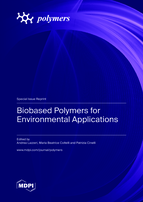Biobased Polymers for Environmental Applications
A special issue of Polymers (ISSN 2073-4360). This special issue belongs to the section "Polymer Applications".
Deadline for manuscript submissions: closed (20 February 2022) | Viewed by 29099
Special Issue Editors
Interests: materials Science; materials engineering; composites; nanomaterials; polymers; biopolymers; bioplastics; nanobiocomposites; polymer processing; mechanical properties; viscoelasticity; modelling
Special Issues, Collections and Topics in MDPI journals
Interests: materials science; polymers; biopolymers; bioplastics; bionanocomposites; nanomaterials; reactive processing; recycling; materials waste management
Special Issues, Collections and Topics in MDPI journals
Interests: biodegradable polymers; sustainability; biobased; composites and nanocomposites
Special Issues, Collections and Topics in MDPI journals
Special Issue Information
Dear Colleagues,
Biobased polymers are attracting a great deal of attention because the extension of their use in replacing fossil-based products is promoting a materials selection oriented to carbon neutrality. The improved modulation of their thermomechanical properties through the design of blends, biocomposites, and bionanocomposites, in addition to exploiting reactive processing techniques, is providing materials with high performances and peculiar functionalities. Moreover, the end-of-life management of biobased polymers can be easier than the fossil-based ones, because they can be recyclable, but—depending on their chemical structure and geometrical features—also compostable or degradable in a controlled environment. Hence, on one hand biobased polymers offer the possibility of differentiating processability and properties for matching the requirements of several applications, and on the other hand, the possibility of designing the best end-of-life scenarios for specific products. Although these beneficial new alternatives require a great deal of efforts to be integrated in the current industrial production and waste management systems, many research activities have been dedicated to these topics. The present Issue aims to gather research and review papers dedicated to replacing fossil-based materials with biobased counterparts with suitable properties, considering not only their structural and functional properties but also the environmental benefits of the new products.
Prof. Andrea Lazzeri
Prof. Maria Beatrice Coltelli
Prof. Patrizia Cinelli
Guest Editors
Manuscript Submission Information
Manuscripts should be submitted online at www.mdpi.com by registering and logging in to this website. Once you are registered, click here to go to the submission form. Manuscripts can be submitted until the deadline. All submissions that pass pre-check are peer-reviewed. Accepted papers will be published continuously in the journal (as soon as accepted) and will be listed together on the special issue website. Research articles, review articles as well as short communications are invited. For planned papers, a title and short abstract (about 100 words) can be sent to the Editorial Office for announcement on this website.
Submitted manuscripts should not have been published previously, nor be under consideration for publication elsewhere (except conference proceedings papers). All manuscripts are thoroughly refereed through a single-blind peer-review process. A guide for authors and other relevant information for submission of manuscripts is available on the Instructions for Authors page. Polymers is an international peer-reviewed open access semimonthly journal published by MDPI.
Please visit the Instructions for Authors page before submitting a manuscript. The Article Processing Charge (APC) for publication in this open access journal is 2700 CHF (Swiss Francs). Submitted papers should be well formatted and use good English. Authors may use MDPI's English editing service prior to publication or during author revisions.
Keywords
- biobased polymers
- bioplastics
- biopolymers
- biocomposites
- bionanocomposites
- biodegradation
- recycling









